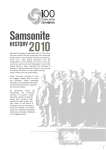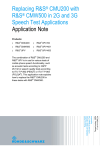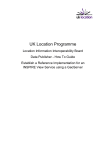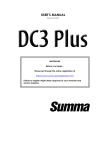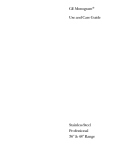Download OS Terrain 5 - Digimap Home Page
Transcript
OS Terrain 5 User guide Contents Section Preface Chapter 1 Chapter 2 Chapter 3 Chapter 4 Chapter 5 Annexe A Page no .................................................................................................................................................. 3 Contact details .......................................................................................................................... 3 Use of the product ..................................................................................................................... 3 Purpose and disclaimer ............................................................................................................ 3 Copyright in this guide .............................................................................................................. 4 Data copyright and other intellectual property rights ................................................................ 4 Trademarks ............................................................................................................................... 4 Back-up provision of the product .............................................................................................. 4 Using this guide......................................................................................................................... 4 Introduction ............................................................................................................................. 5 Using this guide......................................................................................................................... 5 OS Terrain overview ................................................................................................................. 5 OS Terrain 5 ........................................................................................................................ 5 Applications .......................................................................................................................... 5 Features ............................................................................................................................... 6 Accuracy .............................................................................................................................. 6 Supply format ....................................................................................................................... 6 Ordering data ....................................................................................................................... 6 Coverage and file sizes........................................................................................................ 6 INSPIRE compliance ........................................................................................................... 7 Computer hardware ............................................................................................................. 7 Computer software............................................................................................................... 7 OS Terrain 5 ............................................................................................................................. 8 Grid ........................................................................................................................................... 8 Introduction .......................................................................................................................... 8 Mean high and low water representation in grid .................................................................. 8 Contours .................................................................................................................................... 8 Introduction .......................................................................................................................... 8 Feature types ....................................................................................................................... 9 Mean high and low water representation in contours .......................................................... 9 Spot heights ......................................................................................................................... 9 Data, metadata and additional files ..................................................................................... 10 Metadata ................................................................................................................................. 10 Metadata viewing style sheet ............................................................................................. 11 OS Terrain 5 source data ..................................................................................................... 13 Introduction ............................................................................................................................. 13 Coverage ........................................................................................................................... 13 Data revision ...................................................................................................................... 13 Positional accuracy requirements ...................................................................................... 14 Modelling of features in source data .................................................................................. 14 Conformance ..................................................................................................................... 15 The National Grid .................................................................................................................. 17 Product and service performance report form .................................................................. 18 v1.1 – 07/2013 D05300_50 OS Terrain 5 user guide contents v1.1 – 07/2013 © Crown copyright Page 2 of 32 Preface This user guide (hereafter referred to as the guide) is designed to provide an overview of OS Terrain 5 (hereafter referred to as the product) and it gives guidelines and advice on how a customer might derive the maximum benefit from the product. It assumes a general knowledge of geographic information. If you find an error or omission in this guide, or otherwise wish to make a comment or suggestion as to how we can improve the guide, please contact us at the address shown below under contact details or complete the product and service performance report form at annexe A and return it to us. Contact details Our Customer Service Centre will be pleased to deal with your enquiries: Customer Service Centre Ordnance Survey Adanac Drive SOUTHAMPTON SO16 0AS General enquiries (calls charged at local rate): +44 (0)8456 05 05 05 Dedicated Welsh Language HelpLine: 08456 05 05 04 Textphone (deaf and hard of hearing users only please): +44 (0)23 8005 6146 [email protected] www.ordnancesurvey.co.uk If you have difficulty reading this information in its current format and would like to find out how to access it in a different format (Braille, large print, computer disk or in another language), please contact us on: +44 (0)8456 05 05 05. Use of the product The terms and conditions upon which the product, including this guide, is made available to you and your organisation are contained in the customer contract made between you and Ordnance Survey. If there is an inconsistency between the terms of your customer contract and this guide, then the terms of your customer contract prevail. If you or your organisation has not signed a valid current customer contract then you are not entitled to use the product. Purpose and disclaimer This guide is provided for guidance only and does not constitute any warranty, representation, undertaking, commitment or obligation (express or implied) about the product or its suitability for any particular or intended purpose. Any warranties, representations, undertakings, commitments and obligations given by Ordnance Survey about the product and/or its suitability for any particular or intended purpose are set out in your customer contract. It is your responsibility to ensure that this product is suitable for your intended purpose. Ordnance Survey does not accept any liability (whether for breach of contract, negligence or otherwise) for any loss or liability you or any third party may suffer in relying on this guide and any guidance, suggestion, advice or explanation provided in it. Any liability that Ordnance Survey has to you in relation to the product, its supply, use, accuracy, data supplied, functionality or any other liability arising out of or in connection with the product is limited as set out in your customer contract. We may change the information in this guide at any time without notice. We do not accept responsibility for the content of any third party websites referenced or accessed in or through this guide, any contractual documentation, and/or the Ordnance Survey website. OS Terrain 5 user guide preface v1.1 – 07/2013 © Crown copyright Page 3 of 32 Copyright in this guide This guide (including for the avoidance of doubt any mapping images reproduced herein), is © Crown copyright 2013. All rights reserved. Any part of this guide may be copied for use internally in your organisation or business so that you can use the product for the purpose for which it is licensed to your organisation or business (but not otherwise). No part of this guide may be reproduced or transmitted in any form or by any means (including electronically) for commercial exploitation without the prior written consent of Ordnance Survey. No part of this guide may be copied or incorporated in products, services or publications that you generate for onward sale, or as free promotional or support materials, without the prior written consent of Ordnance Survey. Data copyright and other intellectual property rights The Crown (or, where applicable, Ordnance Survey’s suppliers) owns the intellectual property rights in Ordnance Survey digital map data. Additional data has been sourced from third parties, including public sector information licensed under the Open Government Licence v1.0. Full details of the terms and conditions under which Ordnance Survey digital map data may be processed and/or manipulated or copied by a customer – whether or not for use on PCs or workstations or for making hard copies – are available from the Customer Service Centre, please see contact details. You should check the terms and conditions with us before using the data. It is also the responsibility of the holder of the digital map data to ensure that any plotted or printed output contains the required copyright and database acknowledgements in a conspicuous position. Trademarks Ordnance Survey, the OS Symbol, OS Terrain, and Land-Form PROFILE are registered trademarks and OS OpenData is a trademark of Ordnance Survey, the national mapping agency of Great Britain. Adobe and Reader are registered trademarks of Adobe Systems Incorporated Esri and ArcInfo are registered trademarks of Environmental Systems Research Institute, Inc. OpenGIS and OGC are registered trademarks of Open Geospatial Consortium W3C is a registered trademark of Massachusetts Institute of Technology Back-up provision of the product You are advised to copy the supplied data to a back-up medium. Using this guide The documentation is supplied in portable document format (PDF) only. Free Adobe® Reader® software, which displays the guide, incorporates search and zoom facilities and allows you to navigate within. Hyperlinks are used to navigate between associated parts of the guide and to relevant Internet resources by clicking on the blue hyperlinks and the table of contents. If you are unfamiliar with any words or terms used and require clarification please refer to the glossary at the end of the document. OS Terrain 5 user guide preface v1.1 – 07/2013 © Crown copyright Page 4 of 32 Chapter 1 Introduction Using this guide This document consists of: • a user guide, which contains basic information you will need to understand, use and manage ® OS Terrain 5; and • a technical specification, which contains detailed technical information about the data formats. We endeavour to provide the best customer experience and we value your feedback. Annexe A in the user guide contains a product and service performance report form for you to submit any comments on OS Terrain 5. You may also email us at [email protected]. More information including FAQs and updates are available on our web pages http://www.ordnancesurvey.co.uk/oswebsite/products/os-terrain-5/index.html. OS Terrain overview OS Terrain is the name given to Ordnance Survey’s new range of height products. These are three-dimensional models of the bare earth surface known as digital terrain models (DTMs). The range currently consists of: • OS Terrain 5, a mid-resolution DTM, designed to be interoperable with our large-scale data; and • OS Terrain 50, a lower-resolution DTM product, designed for landscape visualisation and analysis over ™ large areas. This is available through OS OpenData . OS Terrain 5 OS Terrain 5 is published as both grid and contours, each in a variety of formats. Both data types are created from the same source data and are supplied as 5 km by 5 km tiles. • OS Terrain 5 grid: a grid of heighted points with regular 5 metre post spacing. • OS Terrain 5 contours: a contour dataset of 5 metre interval standard contour polylines, which includes index contours at 25 m intervals, mean high and low water boundaries and spot heights. Applications OS Terrain 5 provides an ideal base to enable the third dimension for other data within an appropriate geographical information system (GIS). The height data has been created from a source that is also used to update our large-scale data products and it can be used in conjunction with many other Ordnance Survey digital products, for analytical, modelling, planning and visual purposes to enable: • asset/site management; • environmental analysis; • line of sight planning and view-shed modelling; • landscape visualisation and fly-through sequences; • planning and development; • signal propagation; • wind farm location; • flood risk assessment; and • a foundation for 3D modelling. OS Terrain 5 user guide chapter 1 v1.1 – 07/2013 © Crown copyright Page 5 of 32 Features • Maintained within our integrated 3–5 year flying programme and synchronised with our other product updates; • specific modelling of significant features, particularly networks; • available in a variety of formats; • full coverage of Great Britain; • designed to work with Ordnance Survey’s large-scale data; • supplied as both grid and contours with spot heights; • quarterly product updates; • based on the draft Infrastructure for Spatial Data in Europe (INSPIRE) elevation specification; and ® • available in geography markup language (GML) 3.2, using Open Geospatial Consortium (OGC ) simple features profile (level 0). Accuracy OS Terrain 5 has been measured against with GPS points in a range of sample areas to provide a root mean square error (RMSE) value for the height points in each geographic area; urban and major communication routes, rural, and mountain and moorland. The location of these areas will be available on the OS Terrain 5 web page at http://www.ordnancesurvey.co.uk/oswebsite/products/os-terrain-5/index.html. Urban and major communication routes 1.5 metres RMSE* Rural 2.5 metres RMSE Mountain and moorland 2.5 metres RMSE * Root mean square error. This is the average of the mean heights collected in a sample area. The accuracy will be at its highest on modelled features such as roads and lakes. Supply format OS Terrain 5 is available as: • 5 metre grid in ASCII grid and GML 3.2.1 (simple features profile – level 0); and ® • 5 metre contours and spot heights in Esri shapefile or GML 3.2.1 (simple features profile – level 0). Ordering data OS Terrain 5 can be ordered from the Ordnance Survey online ordering service at https://www.ordnancesurvey.co.uk/oswebsite/business/orders/index.html. The data is provided as a full set of Great Britain in tiles and is available as download only. The national dataset is supplied as 10 km by 10 km tiles of data. There are 10 579 data tiles in the product representing each 5 km by 5 km tile grid square. Please note that there are slightly fewer data tiles in the contour set, (10 572) due to the lack of real-world changes in height in those areas. There are metadata files for these tiles. It is recommended that a download manager is used to extract the data as this additional functionality will be able to automate the process and organise the data folders as desired. There are many commercial and open-source download clients available to help manage the data. This data is designed to be kept up to date by quarterly full tile resupply in June, September, December and March each year. Coverage and file sizes OS Terrain 5 is full national coverage of Great Britain derived from source data that consists of new content ® in-filled with approximately 16% Land-Form PROFILE data. The extent of coverage is in sympathy with our large-scale products as the content is derived from source data captured as part of our large-scale revision programme. OS Terrain 5 will become full coverage of new and also refreshed data content in subsequent updates of the product. See the latest coverage map on the OS Terrain 5 web page at http://www.ordnancesurvey.co.uk/oswebsite/products/os-terrain-5/index.html. OS Terrain 5 user guide chapter 1 v1.1 – 07/2013 © Crown copyright Page 6 of 32 Data will be compressed using the zip compression method and is not encrypted. Compression rates vary for contour tiles, dependant on the number of features in the geographic location. A full national supply of OS Terrain 5 is approximately: Grid 6.6 Gb compressed Contours (GML) 1.4 Gb compressed Contours (shapefile) 1.2 Gb compressed INSPIRE compliance OS Terrain 5 is designed to be INSPIRE-ready. Ordnance Survey is a leading member of the UK Location Programme, which is charged with delivering INSPIRE, a directive that applies to all member states and aims to enable more joined-up data across public bodies for environmental applications. At the time of OS Terrain product development, the INSPIRE elevation specification had not been finalised. The data structures of OS Terrain products, and the details of the GML encoding, have been based on the draft INSPIRE specification. The intention is to align OS Terrain with the final INSPIRE specification, when this is available. For more information about INSPIRE and UK Location please view the web pages: http://data.gov.uk/location. Computer hardware This product may be used on a wide range of hardware platforms (provided sufficient memory and storage facilities are available), varying from tablets or computers using GIS or computer-aided design (CAD) to mainframe computers with specialised translators and applications. Please see Coverage and file sizes for more information. Your system supplier will be able to advise on your requirements. Computer software OS Terrain 5 is supplied as inert data in a variety of formats and does not include software for data manipulation. GML is an open standard format and the data may need to be translated into the appropriate format for use within a GIS application. A wide range of GIS software can read the GML contour data without translation. OS Terrain 5 user guide chapter 1 v1.1 – 07/2013 © Crown copyright Page 7 of 32 Chapter 2 OS Terrain 5 This chapter describes the structure of the data in grid and contour forms. Grid In the above image the OS Terrain 5 grid has been shaded in a GIS. Introduction The height data is presented as a raster dataset of height values, which are calculated at the centre of the pixel. This method of creating the data means there are no overlaps between tiles nor common values along the edge. Coordinate reference systems for DTMs may be used to calculate the DTM origin and coordinates of individual posts. Mean high and low water representation in grid Due to local tidal conditions, the height of the mean high and low water mark varies continuously around the coast of Britain. The mean high and low water lines have been have been derived from our large-scale mapping and assigned constant height values, based on the average for each tile. This average value has been determined from local tide tables. The mean high and low water lines were used as heighted breaklines when creating the grid to ensure the grid product is consistent with the contour product. This means that there may be a small discrete step in the height of tidal water between adjacent tiles. For areas of permanent tidal water the height of the mean low water has been extended out to the tile edge to ensure that the tile is complete. Heights in the foreshore area are interpolated between the mean high and low water heights. Contours Introduction The contours are presented as polyline and spot height features. The contour lines have been divided into tiles for product supply. The contour values can be viewed and analysed in a GIS. OS Terrain 5 user guide chapter 2 v1.1 – 07/2013 © Crown copyright Page 8 of 32 The image above shows OS Terrain 5 master and ordinary contours, tidal boundaries and labelled spot heights. Feature types The terms used for the feature types are drawn from the INSPIRE elevation specification. The draft INSPIRE elevation specification requires height values to be held in an attribute called ‘propertyValue’, which has been implemented in the new OS Terrain contour GML. In the shapefile format, the GML feature types and attributes have been followed but with the 10-character limit on shapefile fields, ‘propertyValue’ is abbreviated to ‘PROP_VALUE’. The contours are named ‘master’ and ‘ordinary’, which are equivalent to ‘index’ and ‘standard’ contours in Ordnance Survey’s product, Land-Form PROFILE. Mean high and low water representation in contours In the contour products, the mean high and mean low water lines have been derived from our large-scale mapping and assigned constant height values, based on the average for each tile. This average value has been determined from local tide tables. Inevitably, this means that there is a small discrete step between adjacent tiles. There are no contours supplied between the mean high and low water lines. The ‘LandWaterBoundary’ feature type has an attribute of ‘waterLevelCategory’, which has four possible sub-values: ‘meanHighWater’ and ‘meanLowWater’ or, for Scotland, ‘meanHighWaterSprings’ and ‘meanLowWaterSprings’. This attribution allows their display parameters to be changed to show individual features, as desired. Spot heights These have been created using an algorithm that selects the highest source data point (masspoint) within every enclosed contour that has a difference in height of at least 1 metre. As they are from an interpolated surface of the real world, they cannot be guaranteed as summits or highest points of the feature but it is intended that, in time, the height source data will be enriched by additional spot height data. The GML data model lists the spot height sub-value, ‘spotHeightType’, which allows the potential for formSpot, generic, mountainPass or summit to be used in future releases of the product. Currently, all spot height features are attributed as ‘generic’. It is possible that there will be some instances of spot heights recording lower height values than the enclosing contour but it is likely that these are the result of genuine depressions. OS Terrain 5 user guide chapter 2 v1.1 – 07/2013 © Crown copyright Page 9 of 32 Chapter 3 Data, metadata and additional files The product will be supplied separately for grid or contour as compressed folders for each geographic tile of data. Each compressed folder will consist of data plus a number of additional files. This chapter describes these files and their purpose. Grid data (ASCII and GML) <tile name>.asc Esri ASCII grid data. <tile name>.gml OGC file for the ASCII grid to enable the data to be loaded as GML format. <tile name>.prj File containing the spatial reference system in a format defined by Esri. <tile name>.asc.aux.xml A file that provides parameters to enable default styling in Esri applications. This ensures that the shading is consistent across the data but allows you to apply your own choice of colour ramp. Metadata_<tile name>.xml A metadata file for grid data, providing information on the flying date and so on. Contour data (GML) <tile name>.gml GML data file Metadata_<tile name>.xml A metadata file for contour data providing information on the flying date and so on. Contour data (Esri shapefile) <tile name>_line.shp <tile name>_line.dbf <tile name>_line.shx <tile name>_line.prj Esri shapefiles for contour and tideline data. <tile name>_point.shp <tile name>_point.dbf <tile name>_point.shx <tile name>_point.prj Esri shapefiles for spot height data. Metadata_<tile name>.xml A metadata file for contour data providing information on the flying date and so on. Metadata The XML metadata for the new terrain products follows the GEMINI metadata standard, which Ordnance Survey has committed to for the UK Location Programme and INSPIRE. Ordnance Survey has provided metadata for national sets of products (www.ordnancesurvey.co.uk/oswebsite/xml/products). OS Terrain 5 will also have metadata in this form, on a per-tile basis. The XML metadata contains comments to clarify the meaning of the XML tags used in the file. Name Description XML Product identification Product name OS Terrain 5. gmd:MD_DataIdentification/gmd:citation/gmd:CI_C itation/gmd:collectiveTitle/gco:CharacterString Spatial representation The structure of the data, either grid (DTM) or vector (contours). gmd:MD_DataIdentification/gmd:spatialRepresent ationType/gmd:MD_SpatialRepresentationTypeCode Tile reference 5 km National Grid tile reference. gmd:MD_DataIdentification/gmd:citation/gmd:CI_ Citation/gmd:title/gco:CharacterString Topic category INSPIRE theme: elevation. gmd:MD_DataIdentification/gmd:topicCategory/gm d:MD_TopicCategoryCode Coordinate reference systems The projected coordinate reference system – British National Grid – and the vertical reference system – Ordnance Datum Newlyn. gmd:MD_ReferenceSystem/gmd:referenceSystemIden tifier/gmd:RS_Identifier/gmd:code/gmx:Anchor xlink:href="urn:ogc:def:crs:EPSG::27700"/Briti sh National Grid gmd:MD_ReferenceSystem/gmd:referenceSystemIden tifier/gmd:RS_Identifier/gmd:code/gmx:Anchor xlink:href="urn:ogc:def:crs:EPSG::5701"/Ordnan ce Datum Newlyn OS Terrain 5 user guide chapter 3 v1.1 – 07/2013 © Crown copyright Page 10 of 32 Name Description XML Flying date(s) The date that the area was flown by Ordnance Survey for revision. To accommodate multiple flying dates within the tile, two values will be recorded: earliest flying date then latest flying date present. Both dates can be identical. For Profile content the Date Flown will be recorded as <null>. gmd:MD_DataIdentification/gmd:extent/gmd:EX_Ex tent/gmd:temporalElement/gmd:EX_TemporalExtent /gmd:extent/gml:TimePeriod /gml:beginPosition /gml:endPosition Processing date The date the tile was created by Ordnance Survey, not the date of the real-world change or survey. gmd:MD_DataIdentification/gmd:citation/gmd:CI_C itation/gmd:date/gmd:CI_Date/gmd:date/gco:Date Version number An incrementing number to indicate the number of times the tile has been published. gmd:MD_DataIdentification/gmd:citation/gmd:CI_ Citation/gmd:edition/gco:CharacterString Reason for change This provides information about the update of the data and whether it is creation (new) or a revision (modified/verified) which is described in the metadata by using lineage below. gmd:MD_DataIdentification/gmd:citation/gmd:CI_ Citation/gmd:date/gmd:CI_Date/gmd:dateType/ gmd:CI_DateTypeCode Lineage Text to describe the current status of the tile, either: ‘created from new imagery’, ‘some parts revised from new imagery’, ‘new imagery examined and no change’. gmd:DQ_DataQuality/gmd:lineage/gmd:LI_Lineage/ gmd:statement/gco:CharacterString Change history Metadata viewing style sheet To make the xml easier to read, an XSLT viewing style sheet is provided (OSTerrainMetadataViewingStylesheet.xsl), which converts the XML to HTML for ease of viewing in a web browser. Some browsers and other software will read this automatically if the user is connected to the Internet, as its address is referenced in the metadata but it can also be located on the Ordnance Survey website: http://www.ordnancesurvey.co.uk/xml/stylesheet/OSTerrainMetadataViewingStylesheet.xsl. Metadata xml file example This is a section of the xml file in its native format with the location of the style sheet highlighted. It can be read like this when opened in an xml viewer or basic file reader. <?xml version="1.0" encoding="UTF-8"?> <?xml-stylesheet type="text/xsl" href="http://www.ordnancesurvey.co.uk/xml/stylesheet/OSTerrainMetadataViewingStylesheet.xsl"?> <gmd:MD_Metadata xmlns:gmd="http://www.isotc211.org/2005/gmd" xmlns:gml="http://www.opengis.net/gml/3.2" xmlns:xsi="http://www.w3.org/2001/XMLSchema-instance" xmlns:gmx="http://www.isotc211.org/2005/gmx" xmlns:gco="http://www.isotc211.org/2005/gco" xmlns:xlink="http://www.w3.org/1999/xlink" xsi:schemaLocation="http://www.isotc211.org/2005/gmx http://eden.ign.fr/xsd/isotc211/isofull/20090316/gmx/gmx.xsd"><!-- Unique identifier, required if this record is being used in a metadata management system --> <gmd:fileIdentifier> <gco:CharacterString>OSTerrain5.NT23NE</gco:CharacterString> </gmd:fileIdentifier> <gmd:contact gco:nilReason="missing"></gmd:contact> <gmd:dateStamp> <gco:DateTime>2013-01-08T03:22:25</gco:DateTime> </gmd:dateStamp><!-- Projected Coordinate Reference System --> <gmd:referenceSystemInfo> <gmd:MD_ReferenceSystem> <gmd:referenceSystemIdentifier> <gmd:RS_Identifier> <gmd:code> <gmx:Anchor xlink:href="urn:ogc:def:crs:EPSG::27700">British National Grid</gmx:Anchor> OS Terrain 5 user guide chapter 3 v1.1 – 07/2013 © Crown copyright Page 11 of 32 Metadata xml file referencing the XSLT viewing style sheet example This is the same section of the metadata file above when viewed directly by clicking on the file; thus utilising the style sheet. OS Terrain Tile Metadata Product identification: Product name: OS Terrain 5 Spatial representation: grid Tile reference: NT23NE Topic category: elevation Coordinate reference systems: British National Grid Esri grid styling – asc.aux.xml file This XML file contains min, max, mean and standard deviation height values for the product, in a format defined by Esri. The same values are supplied for every tile. Providing these height statistics is intended to allow colour ramps to be applied by the user, such that adjacent tiles are styled consistently. This can be disabled by moving the asc.aux.xml file from each downloaded zip file or adjusting the parameters of the minimum and maximum heights in a GIS if desired. OS Terrain 5 user guide chapter 3 v1.1 – 07/2013 © Crown copyright Page 12 of 32 Chapter 4 OS Terrain 5 source data Introduction The source DTM for OS Terrain products is captured as a triangulated irregular network (TIN) by editing with mass points and breaklines and/or automated techniques within a photogrammetric environment. The TIN is a superior model for three-dimensional data as it uses triangles, which can retain the edges of features more accurately than a grid, for example. The source data capture is subject to demanding rules defined by the height capture specification. Particular attention is paid to communication routes and features significant to height applications. This section describes some of the key capture requirements from the detailed capture specification that we endeavour to achieve in the source data. The grid and contour products are both interpolated from this source TIN model. Coverage The minimum coverage of the data extends out to the low water mark, defined by Hydrographic Office tables with a height value for each 5 km by 5 km tile. For England and Wales, the low water mark is mean low water (MLW) and for Scotland, mean low water (springs) (MLW(S)). All land wholly within inland water bodies that is represented by topographic area features is captured according to the positional accuracy requirements of the area. The minimum requirement is to capture the outer edge of the feature. The surrounding water will remain flat. Any other land within inland water bodies captured by automated processes will be removed from the data. Data revision Height data will be updated as part of the integrated capture programme, alongside our large-scale data revision. In areas that have already been modelled, update is only required when real-world change has occurred; for example, a new motorway cutting. OS Terrain 5 user guide chapter 4 v1.1 – 07/2013 © Crown copyright Page 13 of 32 Positional accuracy requirements The z values of the source TIN data have to meet positional accuracy requirements according to their geographic location. The terrain has been divided into three classifications – urban and major communication routes, rural, and mountain and moorland – to ensure that modelling reflects customer requirements. The accuracy of the height value above Ordnance Datum Newlyn must achieve the RMSE set for each area, which are not the same as the stated product accuracy. Modelling of features in source data Representation of the surface The height of the bare earth surface is recorded as a series of points with three-dimensional coordinates. The X and Y coordinates are eastings and northings in OSGB36; the Z coordinate is height in metres relative to the datum for the area. The vast majority of areas will record a height relative to Ordnance Datum Newlyn. For a small number of offshore islands, a local datum has been used. The bare earth surface excludes buildings, supported structures and vegetation. Structures that form an obstruction at ground level – such as dams, breakwaters and groynes (wide enough to affect the positional accuracy requirements), bridge revetments and earthworks – are considered to be part of the bare earth surface. Only permanent terrain features (those expected to remain until the next revision period or longer) are modelled. Underground and overhead features Underground and overhead features are, by definition, not the ground surface and are thus not included in a DTM. Underground features are those that are obscured and require excavation to construct. Underground features are not recorded and overhead features are removed from the data. Terrain smoothness The DTM will be free of spikes and wells that do not reflect the real world terrain. A surface that is smooth; that is, one that consists of a regular plane (which may be angled); for example, a road carriageway or railway trackbed, will also appear smooth in the data. Edgematching In order to maintain a seamless database of Great Britain, the data will present seamless tile edges that are not discernible through inspection of the data values. There may be a small edge present or a difference in feature modelling between new content and Land-Form PROFILE tiles until the latter has been fully replaced by new data. There will also be small edges in tidal areas due to local tidal differences. Supported structures Supported structures include bridges, viaducts, jetties or piers on legs, cranes, elevated buildings, and so on. Supported structures are removed from any automatically-generated data where the structure departs from the bare earth surface and an air gap exists. All supported structures will be removed from the data where they would affect the use of the data in a water flow application with due consideration to the positional accuracy requirements of the area. Vegetation Areas of vegetation, such as hedgerows, individual trees and extensive tree cover are removed to ensure the bare earth surface is correctly recorded. Vertical features Locations with a vertical change in height, or overhang, have the height of the top of the feature recorded at the correct planimetric location according to the positional accuracy requirements. The height at the lowest point of the vertical feature is recorded according to positional accuracy requirements of the feature but offset from its real world planimetric position to ensure that there is only one z value present in the same location. OS Terrain 5 user guide chapter 4 v1.1 – 07/2013 © Crown copyright Page 14 of 32 Major communication routes Major communication routes are major road and rail networks identified in our core database. The limits of a road carriageway or railway track bed are modelled to ensure that the route reflects its real-world shape. Modelling is required for changes in height to meet the positional accuracy requirements, to smooth the surface and to remove extraneous features such as road furniture and bridges. Any associated slopes and embankments along the length of the route are also modelled. In all other cases, the surface must be smooth, flat (not necessarily horizontal) and free from undulations. Man-made landforms associated with mineral workings and landfill The outer limits of sites for mineral extraction or landfill will be captured. Within active sites, areas of excavations, depositions or temporary access routes that are likely to remain the same until the next cycle of revision are captured. Where change is likely to occur within the active portion of the site no data is collected. Wholly inactive sites are captured to meet positional accuracy requirements. Contained water bodies greater than 0.7 ha In order to respond to the Flood and Water Management Act 2010, the extent of all flat water bodies that are greater than 0.7 hectares in area (that is, greater than 7 000 cubic metres capacity) will have their limits captured to ensure that the presence of the water body can be inferred from the data. The height of the water recorded is that at the lowest height of the surrounding data. The surface of the water will be flat. Conformance The following measurables are used to determine the accuracy and coverage of modelling in the source TIN data. Positional accuracy Any height value extracted from any point within the coverage and above the high water mark will meet the positional accuracy requirements. Geometric fidelity The DTM will be free of spikes and reflect the general texture of the terrain. Terrain smoothness • Measurable. • The absence of spikes or wells in the data that cause a false height value on a data point or interpolated surface. • A surface smooth in the real world will appear smooth in the data. • Major communication routes will be smooth longitudinally, with no ‘steps’ in the data. • Conformity. • There must be no spikes or wells in the data larger than the value required to meet the positional accuracy requirements of the geographic area. • The difference between gradients in the TIN model at 5 metre intervals should be less than 0.4 (40%) for major communication routes. Feature modelling • Measureable. • Data added to model specific features will reflect the correct relationship to itself and immediatelysurrounding data. • Conformity. • All features with parallel limits that require modelling will have parallel data points recorded in the data. • The relative heights of features in close proximity will be in sympathy. OS Terrain 5 user guide chapter 4 v1.1 – 07/2013 © Crown copyright Page 15 of 32 Absolute accuracy • Measureable. • The coordinate position of any point on the surface as represented by the TIN data compared to the true elevation of the same point. • Conformity. • The RMSE of a selection of points from the real world compared to the data will be within the values stated. • No single point will exceed the 99% confidence level. OS Terrain 5 user guide chapter 4 v1.1 – 07/2013 © Crown copyright Page 16 of 32 Chapter 5 The National Grid OS Terrain 5 is supplied as a whole set of Great Britain divided into 5 km by 5 km tiles. These tiles are identified by quoting the National Grid reference of the south-west corner of the area they cover. Ordnance Survey divides Great Britain into squares 100 km by 100 km. Each of these squares has a unique two-letter reference; for example, TG in the diagram below. To describe a 10 km by 10 km tile, first add a two-digit reference to the 100 km by 100 km square reference, with the easting first followed by the northing; for example, TG23. Then identify which quadrant of that grid square is required and add SW, SE, NW or NE to the reference, for example, TG23SW. For additional information on how to use the National Grid, visit the Ordnance Survey website at: http://www.ordnancesurvey.co.uk OS Terrain 5 user guide chapter 5 v1.1 – 07/2013 © Crown copyright Page 17 of 32 Annexe A Product and service performance report form Ordnance Survey welcomes feedback from its customers about OS Terrain 5. If you would like to share your thoughts with us, please print a copy of this form and when completed post or fax it to the address below. Your name: .......................................................................................................................................................... Organisation: ....................................................................................................................................................... Address: ............................................................................................................................................................... .............................................................................................................................................................................. .............................................................................................................................................................................. Postcode: ............................................................................................................................................................. Phone: .................................................................................................................................................................. Fax: ...................................................................................................................................................................... Email: ................................................................................................................................................................... Quotation or order reference: .............................................................................................................................. Please record your comments or feedback in the space below. We will acknowledge receipt of your form within three (3) working days and provide you with a full reply or a status report within 21 working days. If you are posting this form, please send it to: OS Terrain 5 Product Manager, Ordnance Survey, Adanac Drive, SOUTHAMPTON, SO16 0AS. If you wish to return it by fax, please dial 023 8005 6159. Any personal information that you supply with this report form will be used by Ordnance Survey only in the improvement of its products and services. It will not be made available to third parties. OS Terrain 5 user guide annexe A v1.1 – 07/2013 © Crown copyright Page 18 of 32 OS Terrain 5 Technical specification Contents Section Introduction Chapter 1 Chapter 2 Chapter 3 Chapter 4 Annexe A Page no ................................................................................................................................................ 20 Purpose of this specification and disclaimer ........................................................................... 20 Copyright in this specification ................................................................................................. 20 Technical specification introduction .................................................................................. 21 ASCII grid for OS Terrain 5 grid ........................................................................................... 22 ASCII grid overview ................................................................................................................ 22 Data structure.......................................................................................................................... 22 Header section ................................................................................................................... 22 Number of points ................................................................................................................ 22 Data section ....................................................................................................................... 22 GML for OS Terrain 5 grid and contours ............................................................................ 23 GML overview ......................................................................................................................... 23 GML schema...................................................................................................................... 23 Feature types ..................................................................................................................... 23 GML grid for OS Terrain 5 ...................................................................................................... 24 GML contours and spot heights for OS Terrain 5 ................................................................... 24 Detailed GML model .......................................................................................................... 24 Spot heights ....................................................................................................................... 24 GML feature types ............................................................................................................. 24 Esri shapefile for OS Terrain 5 contours ............................................................................ 27 Esri shapefile overview ........................................................................................................... 27 Detailed shapefile model ................................................................................................... 27 Glossary ................................................................................................................................. 29 v1.1 – 07/2013 OS Terrain 5 technical specification contents v1.1 – 07/2013 © Crown copyright Page 19 of 32 Introduction Purpose of this specification and disclaimer This is the technical specification (hereafter referred to as the specification) applicable to the OS Terrain 5 (hereafter referred to as the product) which is referred to in the Framework Direct Licence, Specific Use Framework Partner Licence or your other customer contract for the product. Copyright in this specification This specification, (including for the avoidance of doubt any mapping images reproduced herein), is © Crown copyright 2013. All rights reserved. Any part of this specification may be copied for use internally in your organisation or business so that you can use OS Terrain 5 for the purpose for which it is licensed to your organisation or business (but not otherwise). No part of this specification may be reproduced or transmitted in any form or by any means (including electronically) for commercial exploitation without the prior written consent of Ordnance Survey. No part of this specification may be copied or incorporated in products, services or publications that you generate for onward sale, or as free promotional or support materials, without the prior written consent of Ordnance Survey. OS Terrain 5 technical specification introduction v1.1 – 07/2013 © Crown copyright Page 20 of 32 Chapter 1 Technical specification introduction The purpose of the technical specification is to: provide a brief description of the presentation of OS Terrain 5 in its supply formats; and provide licensed system suppliers with as much detail as necessary to enable OS Terrain 5 files to be easily understood and processed by application software. OS Terrain 5 is available to download as: 5 metre grid in ASCII grid and GML 3.2.1 (simple features profile – level 0). 5 metre contours and spot heights in GML 3.2.1 (simple features profile – level 0). 5 metre contours and spot heights in Esri shapefile. OS Terrain 5 technical specification chapter 1 v1.1 – 07/2013 © Crown copyright Page 21 of 32 Chapter 2 ASCII grid for OS Terrain 5 grid ASCII grid overview ASCII grid is a generic, text-based DTM format that was originally developed by Esri and it is sometimes ® referred to as ArcInfo ASCII grid or ArcGrid ASCII. This data can be read by most standard GIS software without additional translation. The term ‘data structure’ refers to the organisation and sequence of the records in the data file and not to the geographic topology of the data. Data structure Header section The data is specified as a raster grid, with the height values being calculated as a mean of the heights across the whole 5 metre pixel. To represent this in ASCII grid format, the z values are presented 2.5 m from the north-west corner of the tile (to provide the pixel-centre). The data is presented in rows reading from west to east creating a row of 1000 values. The next row will begin 2.5 m from the western edge 7.5 m south of the northern tile edge (under the first value) and again progressing at 5 m intervals to the east. The header provides the coordinates of the south-west corner (xllcorner and yllcorner) to ensure that a GIS places the data correctly. Number of points ncols 1000 nrows 1000 xllcorner 295000 (example) yllcorner 85000 (example) cellsize 5 21.72 21.82 21.91 22.01 22.07 22.13 22.19 … Data section The height values are presented in the standard ASCII grid format as a series of real values. The height values are given to the nearest 0.01 metre. OS Terrain 5 technical specification chapter 2 v1.1 – 07/2013 © Crown copyright Page 22 of 32 Chapter 3 GML for OS Terrain 5 grid and contours This chapter describes how OS Terrain 5 is defined in GML version 3.2.1. An understanding of XML and XML schema is required. GML overview ® The OpenGIS GML encoding standard, the GML is an XML grammar for expressing geographic features. GML serves as a modelling language for geographic systems as well as an open interchange format for geographic transactions on the Internet. As with most XML-based grammars, there are two parts to the grammar – the schema that describes the document and the instance document that contains the actual data. A GML document is described using a GML schema. This allows users and developers to describe generic geographic datasets that contain points, lines and polygons. http://www.opengeospatial.org/standards/gml/ The GML conforms to GML 3.2.1 simple features (level 0), which is a subset of the full GML specification, intended to make it easier for GIS vendors to provide a minimum level of support for GML. GML schema XML schemas are used to validate the format and content of the GML. The GML specification provides a set of schemas that define the GML feature constructs and geometric types. These are designed to be used as a basis for building application-specific schemas, which define the data content. The OS Terrain 5 application schemas, which are referenced by the data, are available at http://www.ordnancesurvey.co.uk/ The user may need to be connected to the Internet to access these online schemas while working with OS Terrain 5 in GML unless their software supports local copies of the schema. Depending upon the software that is being used to read the data, the user has the following options: • The software does not use the schema; therefore does not need to be connected to the Internet. • The software needs the schema but can reference it from a local copy, if it is downloaded in advance. • The software needs the schema and can only reference it from the online version; therefore needs to be connected to the Internet. Feature types The model is ‘feature based’ so that ‘ContourLine’, ‘SpotHeight’ and ‘LandWaterBoundary’ are feature types with specific attributes. Please see GML contours and spot heights for more information. Coordinate reference system The coordinate reference system for geometries in the OS Terrain GML, is expressed using an EPSG code embedded in a uniform resource name (URN) (urn:ogc:def:crs:EPSG::27700). This is a more generic way of expressing the reference system, rather than osgb:BNG (British National Grid), used in previous Ordnance Survey products. Unique identifiers GML 3.2 requires features and their geometries to have unique identifiers. For OS Terrain products, the feature identifiers have been structured as follows: os.t5.<tile name>.<sequential number>, where the second part abbreviates the product name. Geometry identifiers in the GML use the same form, but with a .geom suffix. Therefore, for a given release of the product, every feature and geometry is guaranteed to have a unique identifier. The products will be updated by whole tile refresh and there are no plans to supply feature-based change-only-update. When a tile is updated, the sequential identifiers are regenerated. OS Terrain 5 technical specification chapter 3 v1.1 – 07/2013 © Crown copyright Page 23 of 32 GML grid for OS Terrain 5 Ordnance Survey is committed to open data formats. The grid data is supplied as ASCII with GML, to enable their use in either format. The GML file does not contain any spatial height data as this data has been provided as an ‘external data block’; that is, the ASCII grid file. The .gml file effectively provides metadata (such as location, grid spacing and the vertical reference system). It also contains spatial reference information in a software-independent form. Currently, common software packages do not support it in this form but the ASCII grid data can be used alone. GML contours and spot heights for OS Terrain 5 Detailed GML model Spot heights These have been created by an automated process to select the highest mass point that is at least 1 metre above and within every closed contour. If the point is the same height as the contour it will be removed. It is possible that some spot heights could be lower than the surrounding contour due to genuine depressions. The z value is rounded to one decimal place. GML feature types The feature types within the contours enable their representation as individual features to enable easier interpretation; for example, the contours can be drawn as different colours to highlight the index contours, the high water mark and spot heights over a certain value. The contours and tidelines have been rounded to two decimal places. The column names have been reformatted to facilitate compliance with Esri software. OS Terrain 5 technical specification chapter 3 v1.1 – 07/2013 © Crown copyright Page 24 of 32 Column name Type Description +geometry GM_LineString The structure of the feature +propertyValue Distance The length of the contour +contourLineType String master ordinary auxiliary Notes The ContourLine sub-type value names align with INSPIRE draft elevation specification. The terms master and ordinary represent the more traditionally-recognised terms index and standard (contours) respectively. ContourLine SpotHeight +geometry GM_Point The structure of the feature +propertyValue Distance The z value (height above Newlyn, or other British height datum) of the feature +spotHeightType String formSpot generic mountainPass summit Notes At launch only the sub-type value generic has been used but the other values provide functionality to enrich the attribution if required in a later product release. LandWaterBoundary +geometry GM_LineString +propertyValue Distance +waterLevelCategory String Notes Mean high and low waters apply to tidal waters in England and Wales and the mean high and low water springs apply to those in Scotland. meanHighWater meanLowWater meanHighWaterSprings meanLowWaterSprings Example of the ContourLine feature types <os:member> <os:ContourLine gml:id="os.t5.sx98se.175"> <os:geometry> <gml:LineString srsName="urn:ogc:def:crs:EPSG::27700" gml:id="os.t5.sx98se.175.geom"> <gml:posList>295487.08 80000 295481.21 80001.48 295480.55 80001.23 295481.75 80000</gml:posList> </gml:LineString> </os:geometry> <os:propertyValue uom="m">15</os:propertyValue> <os:contourLineType>ordinary</os:contourLineType> </os:ContourLine> </os:member> OS Terrain 5 technical specification chapter 3 v1.1 – 07/2013 © Crown copyright Page 25 of 32 Example of the SpotHeight feature types <os:member> <os:SpotHeight gml:id="os.t5.sx98se.0"> <os:geometry> <gml:Point srsName="urn:ogc:def:crs:EPSG::27700" gml:id="os.t5.sx98se.0.geom"> <gml:pos>299161.48 84990.56</gml:pos> </gml:Point> </os:geometry> <os:propertyValue uom="m">31.9</os:propertyValue> <os:spotHeightType>generic</os:spotHeightType> </os:SpotHeight> </os:member> Example of the LandWaterBoundary feature types <os:member> <os:LandWaterBoundary gml:id="os.t5.sx98se.17"> <os:geometry> <gml:LineString srsName="urn:ogc:def:crs:EPSG::27700" gml:id="os.t5.sx98se.17.geom"> <gml:posList>297786.59 81469.64 297783.26 81469.75 297783.26 81466.75 297786.59 81469.64</gml:posList> </gml:LineString> </os:geometry> <os:propertyValue uom="m">1.62</os:propertyValue> <os:waterLevelCategory>meanHighWater</os:waterLevelCategory> </os:LandWaterBoundary> </os:member> OS Terrain 5 technical specification chapter 3 v1.1 – 07/2013 © Crown copyright Page 26 of 32 Chapter 4 Esri shapefile for OS Terrain 5 contours Esri shapefile overview The Esri shapefiles consist of eight separate files for the point and line features. Detailed shapefile model File name Description Examples Contour line files <tile name>_line.shp Shape format The contour geometry <tile name>_line.dbf Shape attribute format A database file that contains the attributes of each feature <tile name>_line.shx Shape index format A positional index of the features to enable searching <tile name>_line.prj Projection format Coordinate reference system information ID FEAT_TYPE SUB_TYPE PROP_VALUE os.t5.sy09ne.113 ContourLine master 25.00 os.t5.sy09ne.114 ContourLine ordinary 05.00 os.t5.sy09ne.115 ContourLine ordinary 70.00 PROJCS["British_National_Grid",GEOGCS["GCS_OSGB_1936",DATUM… OS Terrain 5 technical specification chapter 4 v1.1 – 07/2013 © Crown copyright Page 27 of 32 File name Description Examples Spot height files <tile name>_point.shp Shape format The spot height geometry <tile name>_point.dbf Shape attribute format A database file that contains the attributes of each feature <tile name>_point.shx Shape index format A positional index of the features to enable searching <tile name>_point.prj Projection format Coordinate reference system information ID FEAT_TYPE SUB_TYPE PROP_VALUE os.t5.sy09nw.0 SpotHeight generic 31.00 os.t5.sy09nw.1 SpotHeight generic 22.00 os.t5.sy09nw.2 SpotHeight generic 15.00 PROJCS["British_National_Grid",GEOGCS["GCS_OSGB_1936",DATUM… OS Terrain 5 technical specification chapter 4 v1.1 – 07/2013 © Crown copyright Page 28 of 32 Annexe A Glossary For detailed general information about mapping please visit our support pages online. absolute accuracy A measure that indicates how closely the coordinates of a point in Ordnance Survey map data agree with the true National Grid coordinates of the same point on the ground. As the true position can never be known exactly, the statistic is quoted relative to the best known position determined by precise survey methods. accuracy The closeness of the results of observations, computations or estimates to the true values or the values accepted as being true. Accuracy relates to the exactness of the result, and is a measure of the exactness of the operation by which the result is obtained. ASCII American Standard Code for Information Interchange – a standard binary coding system used to represent characters within a computer. bit An acronym for binary digit. breakline A line indicating discontinuity in a terrain surface; that is, an abrupt change in gradient. byte A unit of computer storage of binary data usually comprising 8 bits, equivalent to a character. Hence megabyte (one million bytes) and gigabyte (one thousand million bytes). character A distinctive mark; an inscribed letter; one of a set of writing-symbols. contour A line connecting points of equal elevation. coordinates Pairs of numbers expressing horizontal distances along orthogonal axes. Alternatively, triplets of numbers measuring horizontal and vertical distances. copyright Copyright is a legal property right that enables the creator of an original work to protect it from unauthorised use. Through the Copyright, Designs and Patents Act 1988, Crown copyright continues to subsist in all Ordnance Survey products until the end of the period of 50 years from the end of the year in which they were published and, in the case of data, from the end of the year in which it was extracted from the Ordnance Survey database. Crown copyright is vested in The Controller of Her Majesty’s Stationery Office, who has delegated powers to the Director General, Ordnance Survey for the administration of copyright in publications and data, including the determination of the rules and terms under which permission for their reproduction is given. currency An expression of the currency of the data; that is, when the real-world change was identified and represented in the data. data A representation of facts, concepts or instructions in a formalised manner suitable for communication, interpretation or processing. data capture The encoding of data. In the context of digital mapping, this includes map digitising, direct recording by electronic survey instruments, and the encoding of text and attributes by whatever means. OS Terrain 5 technical specification annexe A v1.1 – 07/2013 © Crown copyright Page 29 of 32 data format A specification that defines the order in which data is stored or a description of the way data is held in a file or record. data model An abstraction of the real world which incorporates only those properties thought to be relevant to the application or applications at hand. A data model would normally define specific groups of entities and their attributes, and the relationship between these entities. A data model is independent of a computer system and its associated data structures. data point A coordinate pair that defines the position of a point feature, or one of a series of coordinate pairs that defines a line feature. data quality Attributes of a dataset that define its suitability for a particular purpose; for example, completeness, positional accuracy, currency, logical structure and so on. data structure The defined logical arrangement of data as used by a system for data management; a representation of a data model in computer form. data type This defines the structure of a data item. This in turn determines the range of values it can take and the range of operations that can be applied to it. Integer, real and character string are examples of data type. Some modern programming languages allow user-defined types. database An organised, integrated collection of data stored so as to be capable of use by relevant applications, with the data being accessed by different logical paths. Theoretically, it is application-independent, but in reality it is rarely so. dataset An identifiable collection of related data. digital Data that is expressed as numbers (digits) in computer-readable form is said to be digital. digital terrain model (DTM) Also referred to as a digital elevation model (DEM) this primarily defines the ground surface. This will normally exclude ground surface features such as buildings, woodland and so on. eastings See rectangular coordinates. edgematch The process of ensuring that data along the adjacent edges of blocks of data matches in both positional and attribute terms. EPSG code The EPSG Geodetic Parameter Dataset is a structured dataset of Coordinate Reference Systems and Coordinate Transformations. In the dataset, each Coordinate Reference System has its own unique code number. It was created by the European Petroleum Survey Group and is maintained by the Geodesy Subcommittee of OGP (International Association of Oil and Gas Producers). feature An item of detail within a digital map that can be represented by a point, symbol, text or line. feature identifier A unique code to identify an individual feature. A specified part of a record containing a unit of data, such as the date of digitising. The unit of data may be a data element or a data item. OS Terrain 5 technical specification annexe A v1.1 – 07/2013 © Crown copyright Page 30 of 32 field A specified part of a data file containing a unit of data, such as the date of flying. format The specified arrangement of data in a file. geographical information system (GIS) A system for capturing, storing, checking, integrating, analysing and displaying data that is spatially-referenced to the Earth. This is normally considered to involve a spatially-referenced computer database and appropriate applications software. Geography Markup Language (GML) GML was developed by the Open Geospatial Consortium (OGC), a global organisation of developers and users that aims to maximise the benefit of geographic information. GML is a spatially enabled dialect of XML schema. Global Positioning System (GPS) ® The Navstar global positioning system (GPS) is a constellation of orbiting satellites that provides navigation data to military and civilian users all over the world. The system is operated and controlled by members of the 50th Space Wing located at Schriever Air Force Base (AFB), Colorado. grid The planimetric frame of reference; for example, the National Grid or the consistent alignment of data points. kilobyte (Kb) A total of 1 024 bytes; a measure of data storage capacity. line A series of connected coordinated points forming a simple feature with homogeneous attribution. mean high Water/springs (MHW or MHWS) Depiction of the encroachment of land by tidal waters at mean highest levels – spring tides in Scotland. mean low Water/springs (MLW or MLWS) Depiction of limits of tidal waters at mean lowest ebb – spring tides in Scotland. megabyte (Mb) A total of 1 048 576 bytes; a measure of data storage capacity. National Grid The metric grid on a Transverse Mercator projection used by Ordnance Survey on all post-war mapping to provide an unambiguous spatial reference in Great Britain for any place or entity, whatever the map scale. northings See rectangular coordinates. Open Geospatial Consortium (OGC) A global organisation of developers and users that aims to maximise the benefit of geographic information. origin The zero point in a system of rectangular Cartesian coordinates. photogrammetry The science, art and technology of obtaining reliable measurements and maps from aerial photographs. point A zero-dimensional spatial abstraction of an object represented as a coordinate pair. point feature A zero-dimensional spatial abstraction of an object with its position defined by a coordinate pair. Points may also be represented by symbols, which may have attributes such as orientation and size. OS Terrain 5 technical specification annexe A v1.1 – 07/2013 © Crown copyright Page 31 of 32 positional accuracy The degree to which the coordinates define a point’s true position in the world, directly related to the spheroid and/or projection on which the coordinates system is based. rectangular coordinates Also known as x-y coordinates and as eastings and northings. These are two-dimensional coordinates that measure the position of any point relative to an arbitrary origin on a plane surface; for example, a map projection, a digitising table or a VDU screen. Route mean square error (RMSE) This is the square root of the mean of the squares of the errors between observations, such as GPS points. shapefile This is a data format developed by Esri to describe features such as points, lines and polygons to enable spatial analysis. A shapefile consists of a number of files designed to hold information essential for the transfer of this data between software products that are capable of reading shapefiles. spot height A point on the Earth’s surface for which the height, above a reference datum, is known and which has been fixed by observation. transfer format The format used to transfer data consistently between computer systems. In general usage this can refer not only to the organisation of data but also to the associated information, such as attribute codes, which are required in order to successfully complete the transfer. triangulated irregular network (TIN) This is a vector data structure that represents a surface in three dimensions. Mass-points (or z-values) are joined up as irregular triangles to form a surface to provide a more accurate and less dense method of representing a digital terrain model. This is because the edges of features are preserved and mass-points are only depicted where necessary to depict changes in slope. URN Uniform Resource Name is a type of uniform resource identifier (URI), which was developed in the early stages of the Internet to strengthen the links between documents by providing a registered namespace. Extensible Markup Language (XML) This is a markup language written in a textual data format designed to encode documents and data ® structures for transfer over the Internet. It was developed by the World Wide Web Consortium (W3C ). XML schemas express shared vocabularies and allow machines to carry out rules made by people. They provide a means for defining the structure, content and semantics of XML documents. Extensible Stylesheet Language Transformations (XSLT) This is a language for transforming XML documents into objects that can be presented in a format that is more easily read by the user, such as HTML for web pages or plain text. OS Terrain 5 technical specification annexe A v1.1 – 07/2013 © Crown copyright Page 32 of 32
































